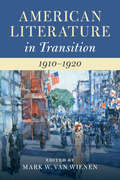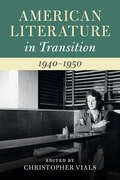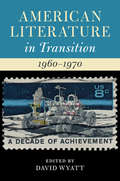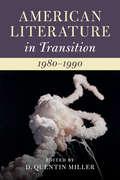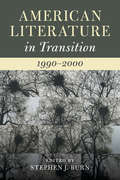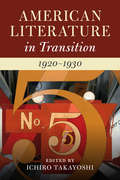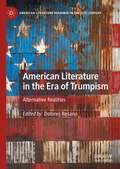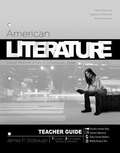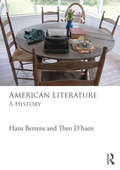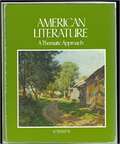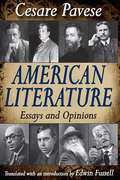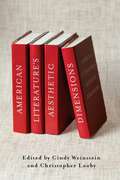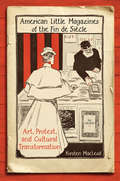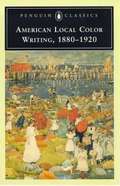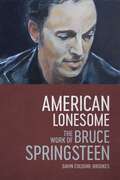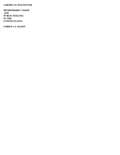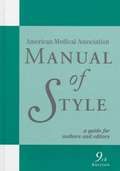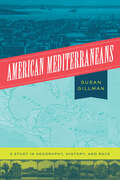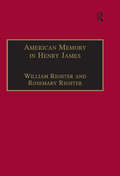- Table View
- List View
American Literature in Transition, 1910–1920
by Van Wienen Mark W.American Literature in Transition: 1910-1920 offers provocative new readings of authors whose innovations are recognized as inaugurating Modernism in US letters, including Robert Frost, Willa Cather, T. S. Eliot, Ezra Pound, Gertrude Stein, H. D. , and Marianne Moore. Gathering the voices of both new and established scholars, the volume also reflects the diversity and contradictions of US literature of the 1910s. 'Literature' itself is construed variously, leading to explorations of jazz, the movies, and political writing as well as little magazines, lantern slides, and sports reportage. One section of thematic essays cuts across genre boundaries. Another section oriented to formats drills deeply into the workings of specific media, genres, or forms. Essays on institutions conclude the collection, although a critical mass of contributors throughout explore long-term literary and cultural trends - where political repression, race prejudice, war, and counterrevolution are no less prominent than experimentation, progress, and egalitarianism.
American Literature in Transition, 1930–1940 (American Literature in Transition)
by Ichiro TakayoshiAmerican Literature in Transition, 1930–1940 gathers together in a single volume preeminent critics and historians to offer an authoritative, analytic, and theoretically advanced account of the Depression era's key literary events. Many topics of canonical importance, such as protest literature, Hollywood fiction, the culture industry, and populism, receive fresh treatment. The book also covers emerging areas of interest, such as radio drama, bestsellers, religious fiction, internationalism, and middlebrow domestic fiction. Traditionally, scholars have treated each one of these issues in isolation. This volume situates all the significant literary developments of the 1930s within a single and capacious vision that discloses their hidden structural relations - their contradictions, similarities, and reciprocities. This is an excellent resource for undergraduate, graduate students, and scholars interested in American literary culture of the 1930s.
American Literature in Transition, 1940–1950 (American Literature In Transition Ser.)
by Christopher VialsIn the aftermath of World War II, the United States emerged as the dominant imperial power, and in US popular memory, the Second World War is remembered more vividly than the American Revolution. American Literature in Transition, 1940-1950 provides crucial contexts for interpreting the literature of this period. Essays from scholars in literature, history, art history, ethnic studies, and American studies show how writers intervened in the global struggles of the decade: the Second World War, the Cold War, and emerging movements over racial justice, gender and sexuality, labor, and de-colonization. One recurrent motif is the centrality of the political impulse in art and culture. Artists and writers participated widely in left and liberal social movements that fundamentally transformed the terms of social life in the twentieth century, not by advocating specific legislation, but by changing underlying cultural values. This book addresses all the political impulses fueling art and literature at the time, as well as the development of new forms and media, from modernism and noir to radio and the paperback.
American Literature in Transition, 1960–1970 (American Literature in Transition)
by David WyattThe decade of the 1960s has come to occupy a uniquely seductive place in both the popular and the historical imagination. While few might disagree that it was a transformative period, the United States remains divided on the question of whether the changes that occurred were for the better or for the worse. Some see it as a decade when people became more free; others as a time when people became more lost. American Literature in Transition, 1960–1970 provides the latest scholarship on this time of fateful turning as seen through the eyes of writers as various as Toni Morrison, Gary Snyder, Michael Herr, Amiri Baraka, Joan Didion, Louis Chu, John Rechy, and Gwendolyn Brooks. This collection of essays by twenty-five scholars offers analysis and explication of the culture wars surrounding the period, and explores the enduring testimonies left behind by its literature.
American Literature in Transition, 1980–1990
by D. Quentin MillerHistory has not been kind to the 1980s. The decade is often associated with absurd fashion choices, neo-Conservatism in the Reagan/Bush years, the AIDS crisis, Wall Street ethics, and uninspired television, film, and music. Yet the literature of the 1980s is undeniably rich and lasting. American Literature in Transition, 1980-1990 seeks to frame some of the decade's greatest achievements such as Toni Morrison's monumental novel Beloved and to consider some of the trends that began in the 1980s and developed thereafter, including the origins of the graphic novel, prison literature, and the opening of multiculturalism vis--vis the 'canon wars'. This volume argues not only for the importance of 1980s American literature, but also for its centrality in understanding trends and trajectories in all contemporary literature against the broader background of culture. This volume serves as both an introduction and a deep consideration of the literary culture of our most maligned decade.
American Literature in Transition: 1990–2000
by Stephen J. BurnWritten in the shadow of the approaching millennium, American literature in the 1990s was beset by bleak announcements of the end of books, the end of postmodernism, and even the end of literature. Yet, as conservative critics marked the century's twilight hours by launching elegies for the conventional canon, American writers proved the continuing vitality of their literature by reinvigorating inherited forms, by adopting and adapting emerging technologies to narrative ends, and by finding new voices that had remained outside that canon for too long. By reading 1990s literature in a sequence of shifting contexts - from independent presses to the AIDS crisis, and from angelology to virtual reality - American Literature in Transition, 1990-2000 provides the fullest map yet of the changing shape of a rich and diverse decade's literary production. It offers new perspectives on the period's well-known landmarks, Toni Morrison, Thomas Pynchon, David Foster Wallace, but also overdue recognition to writers such as Ana Castillo, Evan Dara, Steve Erickson, and Carole Maso.
American Literature in Transition: American Literature in Transition, 1920–1930
by Ichiro TakayoshiAmerican Literature in Transition, 1920-1930 examines the dynamic interactions between social and literary fields during the so-called Jazz Age. It situates the era's place in the incremental evolution of American literature throughout the twentieth century. Essays from preeminent critics and historians analyze many overlapping aspects of American letters in the 1920s and re-evaluate an astonishingly diverse group of authors. Expansive in scope and daring in its mixture of eclectic methods, this book extends the most exciting advances made in the last several decades in the fields of modernist studies, ethnic literatures, African-American literature, gender studies, transnational studies, and the history of the book. It examines how the world of literature intersected with other arts, such as cinema, jazz, and theater, and explores the print culture in transition, with a focus on new publishing houses, trends in advertising, readership, and obscenity laws.
American Literature in the Era of Trumpism: Alternative Realities (American Literature Readings in the 21st Century)
by Dolores ResanoThis edited collection offers an exploration of American literature in the age of Trumpism—understood as an ongoing sociopolitical and affective reality—by bringing together analyses of some of the ways in which American writers have responded to the derealization of political culture in the United States and the experience of a ‘new’ American reality after 2016. The volume’s premise is that the disruptions and dislocations that were so exacerbated by the political ascendancy of Trump and his spectacle-laden presidency have unsettled core assumptions about American reality and the possibilities of representation. The blurring of the relationship between fact and fiction, bolstered by the discourses of ‘fake news’ and ‘alternative facts,’ has not only drawn attention to the shattering of any notion of ‘shared’ reality, but has also forced a reexamination of the purpose and value of literature, especially when considering its troubled relation to the representation of ‘America.’ The authors in this collection respond to the invitation to reassess the workings of fiction and critique in an age of Trumpism by considering some of the most recent literary responses to the (new) American realit(ies)—including works by Colson Whitehead, Ben Winters, Claudia Rankine, Gary Shteyngart, Jennifer Egan, and Steve Erickson, to name but a few—, some of which were composed in the run-up to the 2016 election but were able to accurately and incisively imagine the world to come.
American Literature, Grade 11, Volume 1 (HMH Into Literature)
by Kylene Beers Elena Izquierdo Martha HougenNIMAC-sourced textbook
American Literature, Grade 11, Volume 2 (HMH Into Literature)
by Kylene Beers Elena Izquierdo Martha HougenNIMAC-sourced textbook
American Literature-Student
by James P. StobaughEnjoy beloved classics while developing vocabulary, reading, and critical thinking skills! Each literature book in the series is a one-year course Each chapter has five lessons with daily concept-building exercises, warm-up questions, and guided readings Easy-to-use with suggested reading schedules and daily calendar Equips students to think critically about philosophy and trends in culture, and articulate their views through writing A well-crafted presentation of whole-book or whole-work selections from the major genres of classic literature (prose, poetry, and drama), each course has 34 chapters representing 34 weeks of study, with an overview of narrative background material on the writers, their historical settings, and worldview. The rich curriculum's content is infused with critical thinking skills, and an easy-to-use teacher's guide outlines student objectives with each chapter, providing the answers to the assignments and weekly exercises. The final lesson of the week includes both the exam, covering insights on the week's chapter, as well as essays developed through the course of that week's study, chosen by the educator and student to personalize the coursework for the individual learner.
American Literature-Teacher
by James P. StobaughEnjoy beloved classics while developing vocabulary, reading, and critical thinking skills! Each literature book in the series is a one-year course Each chapter has five lessons with daily concept-building exercises, warm-up questions, and guided readings Easy-to-use with suggested reading schedules and daily calendar Equips students to think critically about philosophy and trends in culture, and articulate their views through writing A well-crafted presentation of whole-book or whole-work selections from the major genres of classic literature (prose, poetry, and drama), each course has 34 chapters representing 34 weeks of study, with an overview of narrative background material on the writers, their historical settings, and worldview. The rich curriculum's content is infused with critical thinking skills, and an easy-to-use teacher's guide outlines student objectives with each chapter, providing the answers to the assignments and weekly exercises. The final lesson of the week includes both the exam, covering insights on the week's chapter, as well as essays developed through the course of that week's study, chosen by the educator and student to personalize the coursework for the individual learner.
American Literature: A History
by Hans Bertens Theo D'haenThis comprehensive history of American Literature traces its development from the earliest colonial writings of the late 1500s through to the present day. This lively, engaging and highly accessible guide: <p><p> offers lucid discussions of all major influences and movements such as Puritanism, Transcendentalism, Realism, Naturalism, Modernism and Postmodernism <p> draws on the historical, cultural, and political contexts of key literary texts and authors <p> covers the whole range of American literature: prose, poetry, theatre and experimental literature <p> includes substantial sections on native and ethnic American literatures <p> explains and contextualises major events, terms and figures in American history. <p> This book is essential reading for anyone seeking to situate their reading of American Literature in the appropriate religious, cultural, and political contexts.
American Literature: A Thematic Approach
by G. Robert Carlsen Edgar H. Schuster Anthony TovattA thematically arranged anthology of poems, short stories, plays, novellas, and excerpts from longer works by American authors.
American Literature: Essays and Opinions
by Cesare Pavese Edwin FussellAn Italian author presents his views of American literature.
American Literature: Essays and Opinions (Princeton Legacy Library #1332)
by Cesare PaveseCesare Pavese (1908-1950) was the leading Italian scholar of American literature of the generation that came to maturity under Mussolini. He was not only an acute and wide-ranging literary critic, but also a sensitive poet and novelist. In addition, he was a prodigious translator. In collaboration with Elio Vittorini, he translated and brought to the attention of the Italian public the works of many important American writers. American literature helped to give direction to Pavese's creative work and was a resource for his personal literary campaign against Fascism.Pavese was a non-academic critic, though far less anti - academic than D. H. Lawrence. His first purpose was to use American literature to subvert Italian literature, but beyond that there were a number of issues on which he disagreed with standard American criticism. When he does, his wild, original energy of discovery can trigger a welcome change of focus for our views of American writing.Pavese never visited or lived in America; it was for him a foreign country, although a shifting and sliding special case. He had no stake in its sectional chauvinisms. He had a vital stake in its whole literature because, as his communications to Vittorini make clear, he had a stake in the literature of the whole world. For a while, America seemed to him the probable center of that whole. This was the center where things were happening in the world of the mind, and where the future was being born and licked into shape. Paveses's writings about American literature still offer original and unsparing insights.
American Literature’s Aesthetic Dimensions
by Cindy Weinstein Christopher. Eds. LoobyRethinking the category of aesthetics in light of recent developments in literary theory and social criticism, the contributors to this volume showcase the interpretive possibilities available to those who bring politics, culture, ideology, and conceptions of identity into their critiques. Essays combine close readings of individual works and authors with more theoretical discussions of aesthetic theory and its relation to American literature. In their introduction, Weinstein and Looby argue that aesthetics never left American literary critique. <P><P> Instead, the essay casts the current "return to aesthetics" as the natural consequence of shortcomings in deconstruction and new historicism, which led to a reconfiguration of aesthetics. Subsequent essays demonstrate the value and versatility of aesthetic considerations in literature, from eighteenth-century poetry to twentieth-century popular music. Organized into four groups—politics, form, gender, and theory—contributors revisit the canonical works of Henry James, Nathaniel Hawthorne, and Stephen Crane, introduce the overlooked texts of Constance Fenimore Woolson and Earl Lind, and unpack the complexities of the music of The Carpenters. Deeply rooted in an American context, these essays explore literature's aesthetic dimensions in connection to American liberty and the formation of political selfhood.Contributors include Edward Cahill, Ivy G. Wilson, June Ellison, Dorri Beam, Christopher Castiglia, Christopher Looby, Wendy Steiner, Cindy Weinstein, Trish Loughran, Jonathan Freedman, Elisa New, Dorothy Hale, Mary Esteve, Eric Lott, Sianne Ngai
American Little Magazines of the Fin de Siecle: Art, Protest, and Cultural Transformation (Studies in Book and Print Culture)
by Kirsten MacLeodIn American Little Magazines of the Fin de Siecle, Kirsten MacLeod examines the rise of a new print media form – the little magazine – and its relationship to the transformation of American cultural life at the turn of the twentieth century. Though the little magazine has long been regarded as the preserve of modernist avant-gardes and elite artistic coteries, for whom it served as a form of resistance to mass media, MacLeod’s detailed study of its origins paints a different picture. Combining cultural, textual, literary, and media studies criticism, MacLeod demonstrates how the little magazine was deeply connected to the artistic, social, political, and cultural interests of a rising professional-managerial class. She offers a richly contextualized analysis of the little magazine’s position in the broader media landscape: namely, its relationship to old and new media, including pre-industrial print forms, newspapers, mass-market magazines, fine press books, and posters. MacLeod’s study challenges conventional understandings of the little magazine as a genre and emphasizes the power of “little” media in a mass-market context.
American Local Color Writing, 1880-1920
by Elizabeth Ammons Valerie Rohy<p>The era in the United States between the Civil War and the end of World War I, was marked by increased nation-building, immigration, internal migration and racial tension. This period of time saw the rise of local colour literature, which described the peculiarities of regional life through "lived experiences." This anthology brings together works from every part of America, written by men and women of many cultures, ethnicities, ideologies and literary styles. The book features such familiar writers as Joel Chandler Harris, Kate Chopin, Hamlin Garland and Sarah Orne Jewett, and introduces less well-known voices like Sui Sin Far, Abraham Cahan and Zitkala-Sa. The writings illuminate varying concepts of the American identity and racial, class and ethnic stereotypes are both introduced and challenged in many of of the stories. <p>For more than seventy years, Penguin has been the leading publisher of classic literature in the English-speaking world. With more than 1,700 titles, Penguin Classics represents a global bookshelf of the best works throughout history and across genres and disciplines. Readers trust the series to provide authoritative texts enhanced by introductions and notes by distinguished scholars and contemporary authors, as well as up-to-date translations by award-winning translators.</p>
American Lonesome: The Work of Bruce Springsteen
by Gavin Cologne-BrookesAmerican Lonesome: The Work of Bruce Springsteen begins with a visit to the Jersey Shore and ends with a meditation on the international legacy of Springsteen’s writing, music, and performances. Gavin Cologne-Brookes’s innovative study of this popular musician and his position in American culture blends scholarship with personal reflection, providing both an academic examination of Springsteen’s work and a moving account of how it offers a way out of emotional solitude and the potential lonesomeness of modern life. <P><P>Cologne-Brookes proposes that the American philosophical tradition of pragmatism, which assesses the value of ideas and arguments based on their practical applications, provides a lens for understanding the diversity of perspectives and emotions encountered in Springsteen’s songs and performances. Drawing on pragmatist philosophy from William James to Richard Rorty, Cologne-Brookes examines Springsteen’s formative environment and outsider psychology, arguing that the artist’s confessed tendency toward a self-reliant isolation creates a tension in his work between lonesomeness and community. He considers Springsteen’s portrayals of solitude in relation to classic and contemporary American writers, from Frederick Douglass, Nathaniel Hawthorne, and Emily Dickinson to Richard Wright, Flannery O’Connor, and Joyce Carol Oates. As part of this critique, he discusses the difference between escapist and pragmatic romanticism, the notion of multiple selves as played out both in Springsteen’s work and in our perception of him, and the impact of performances both recorded and live. By drawing on his own experiences seeing Springsteen perform—including on tours showcasing the album The River in 1981 and 2016—Cologne-Brookes creates a book about the intimate relationship between art and everyday life. <P><P>Blending research, cultural knowledge, and creative thinking, American Lonesome dissolves any imagined barriers between the study of a songwriter, literary criticism, and personal testimony.
American Magnitude: Hemispheric Vision and Public Feeling in the United States
by Christa J. OlsonAt a moment in US politics when racially motivated nationalism, shifting relations with Latin America, and anxiety over national futures intertwine, understanding the long history of American preoccupation with magnitude and how it underpins national identity is vitally important. In American Magnitude, Christa J. Olson tracks the visual history of US appeals to grandeur, import, and consequence (megethos), focusing on images that use the wider Americas to establish US character. Her sources—including lithographs from the US-Mexican War, pre–Civil War paintings of the Andes, photo essays of Machu Picchu, and WWII-era films promoting hemispheric unity—span from 1845 to 1950 but resonate into the present. <p><p>Olson demonstrates how those crafting the appeals that feed the US national imaginary—artists, scientists, journalists, diplomats, and others—have invited US audiences to view Latin America as a foil for the greatness of their own nation and encouraged white US publics in particular to see themselves as especially American among Americans. She reveals how each instance of visual rhetoric relies upon the eyes of others to instantiate its magnitude—and falters as some viewers look askance instead. The result is the possibility of a post-magnitude United States: neither great nor failed, but modest, partial, and imperfect.
American Medical Association Manual of Style: A Guide for Authors and Editors (9th edition)
by Cheryl IversonThe latest edition features an expanded chapter on legal and ethical concerns in publishing. Readers will also find an extensive chapter on statistics, a completely updated chapter on nomenclature, new policies for eponyms and numbers styles, a larger references section, an expanded discussion of inclusive language and abbreviations, and a larger section on figures and tables. A new section on typography is also featured, along with current information on electronic publishing, encompassing rapid changes affecting the publishing environment. End-of-chapter references make the book easier to use, and the entire text is reviewed by more than 70 editors for accuracy and dependability.
American Mediterraneans: A Study in Geography, History, and Race
by Susan GillmanThe story of the “American Mediterranean,” both an idea and a shorthand popularized by geographers, historians, novelists, and travel writers from the early nineteenth century to the 1970s. The naturalist Alexander von Humboldt, visiting the Gulf-Caribbean in the early nineteenth century, called it America’s Mediterranean. Almost a century later, Southern California was hailed as “Our Mediterranean, Our Italy!” Although “American Mediterranean” is not a household phrase in the United States today, it once circulated widely in French, Spanish, and English as a term of art and folk idiom. In this book, Susan Gillman asks what cultural work is done by this kind of unsystematic, open-ended comparative thinking.American Mediterraneans tracks two centuries of this geohistorical concept, from Humboldt in the early 1800s, to writers of the 1890s reflecting on the Pacific world of the California coast, to writers of the 1930s and 40s speculating on the political past and future of the Caribbean. Following the term through its travels across disciplines and borders, American Mediterraneans reveals a little-known racialized history, one that paradoxically appealed to a range of race-neutral ideas and ideals.
American Memory in Henry James: Void and Value
by William RighterAmerican Memory in Henry James is about the cultural, historical and moral dislocations at the heart of Henry James' explorations of American identity - between power and love; modernity and history; indeterminate social forms and enduring personal values. The text covers the power, and the limits, of the language of morality and interpretive imagination as James grapples with what America and Europe have in common; and also with what, because their contexts and sense of history are so profoundly different, they cannot have in common. Righter's great theme is the tensions that impelled James ultimately to stretch the novel, his beloved 'prodigious form', almost to breaking point, in search of an ultimately elusive synthesis. The American Scene - his account of an America, revisited after long absence, that was reinventing itself right down to the touchstones of its identity - is its entry point; The Golden Bowl is its primary testing ground. The questions raised transcend the historical moment and the specifically Jamesian sense of dislocation, to go to the heart of modern identity, and the nature of literary endeavour.
American Metempsychosis: Emerson, Whitman, and the New Poetry
by John Michael CorriganThe “transmigration of souls is no fable. I would it were, but men and women are only half human.” With these words, Ralph Waldo Emerson confronts a dilemma that illuminates the formation of American individualism: to evolve and become fully human requires a heightened engagement with history. Americans, Emerson argues, must realize history’s chronology in themselves—because their own minds and bodies are its evolving record. Whereas scholarship has tended to minimize the mystical underpinnings of Emerson’s notion of the self, his depictions of “the metempsychosis of nature” reveal deep roots in mystical traditions from Hinduism and Buddhism to Platonism and Christian esotericism. In essay after essay, Emerson uses metempsychosis as an open-ended template to understand human development.In Leaves of Grass, Walt Whitman transforms Emerson’s conception of metempsychotic selfhood into an expressly poetic event. His vision of transmigration viscerally celebrates the poet’s ability to assume and live in other bodies; his American poet seeks to incorporate the entire nation into his own person so that he can speak for every man and woman.
